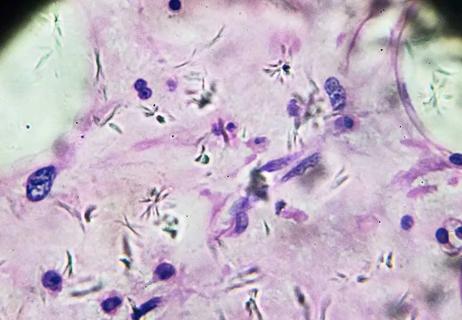How to overcome barriers to care

Cancer is among the leading causes of death in the world, according to the National Cancer Institute.
Advertisement
Cleveland Clinic is a non-profit academic medical center. Advertising on our site helps support our mission. We do not endorse non-Cleveland Clinic products or services. Policy
While there are several types of cancer screenings available, some are specific your anatomy, like cervical, ovarian or prostate screening. Transgender people may find that existing health screening protocols leave them out.
More than 1.4 million Americans are transgender. Overall, this community is less likely to seek out information on cancer screenings or get them for many reasons.
“We know that many transgender people may be underinsured or uninsured, making it difficult or harder to access screenings that may be unaffordable for them,” says transgender health specialist Henry Ng, MD.
Dr. Ng talks about the importance of cancer screenings and how you can overcome barriers to getting the healthcare you need.
In 2021, an estimated 1,806,590 new cases of cancer will be diagnosed in the United States, and 606,520 people will die from the disease, according to the American Cancer Society.
Having access to cancer screenings — especially in the transgender community — is vital, says Dr. Ng. Studies have shown that health, personal and economic barriers in transgender communities can result in a higher risk of certain cancers like lung and cervical cancer.
“If we don’t have transgender folks at the table, and we don’t move the table to where people are, people will develop cancer, potentially at higher rates. Others will be detected when it’s entirely too late,” Dr. Ng says.
Advertisement
There are numerous obstacles transgender people face when it comes to receiving healthcare, let alone cancer screenings. Here are a few:
If you're searching for a new doctor or seeking healthcare, there are a few things you can do to ensure you have a positive experience.
Several factors — like obesity and substance use — can magnify the health differences and impact of cancer in the transgender community. The general rule to follow: If you have a body part and there’s a cancer screening available, you should receive that screening. Here are a few screenings:
The American Cancer Society recommends getting a yearly mammogram if you're between 45 and 54. This is an important screening if you’re transgender, as the use of progestin and estrogen can increase your risk of breast cancer.
Advertisement
You may be uncomfortable with mammograms. Dr. Ng suggests asking about alternative options, like a breast MRI or ultrasound.
Screening for cervical cancer, called a Pap smear or Pap test, should begin at age 21. Performed as part of a pelvic exam, doctors can also test for human papillomavirus (HPV), a common sexually transmitted infection (STI) that increases your risk of cervical cancer. You should get screened every three to five years per 2021 ACOG guidelines.
Taking testosterone can lead to changes in the cervix that may look abnormal. Make sure to notify your healthcare provider of hormone use before a Pap smear.
If you're at high risk for cervical cancer or find the procedure upsetting, a hysterectomy that includes removing the cervix may be an option.
It can be difficult to detect ovarian cancer until it has spread. Your doctor will examine your ovaries and uterus during a pelvic exam. If you have symptoms, like bloating in your abdomen, or your doctor recommends further testing, you may undergo an ultrasound, computer tomography (CT) scan or magnetic resonance imaging (MRI).
If you're uncomfortable with pelvic exams, the removal of the ovaries, uterus and cervix may be recommended.
Advertisement
The American Cancer Society recommends starting prostate cancer screening around age 55. A digital rectal exam is the main way to screen for prostate cancer. But your doctor may order a prostate-specific antigen (PSA) blood test. If you were born with a penis, you should be screened every year or two based on your PSA levels.
If you've undergone adult genital surgery, you still likely have a prostate. While there has been some research about estrogen and prostate cancer, the risk is low.
If you’re unsure about whether you need a screening or not, check with a trusted healthcare provider. If you do receive a cancer diagnosis, community programs and support groups can provide a lot of information and comfort.
“See if there are community programs in your area that address cancer,” says Dr. Ng. “Having a network around you can help support you during a particularly challenging and vulnerable time in your life.”
Advertisement
Learn more about our editorial process.
Advertisement

Rates of early-onset breast, colorectal and GI cancers are increasing, but preventive care and a healthy lifestyle can help reduce your risk

The side effects of cancer and treatment can impact desire, sexual function and intimacy, but there are ways you can keep the flame going

Decisions you make regarding smoking, alcohol use, meal choices and exercise can make a big difference

When you’re living with cancer, eating enough protein and a variety of colorful foods can help you keep up your strength and energy

Practice meditation together, make a unique-to-them care package and embrace emotions

Taming fear and reclaiming your future after treatment

Carcinomas are the most common and affect skin and organs

7 healthy eating tips to help reduce your risk of some of the most common types of cancer

If you’re feeling short of breath, sleep can be tough — propping yourself up or sleeping on your side may help

If you fear the unknown or find yourself needing reassurance often, you may identify with this attachment style

If you’re looking to boost your gut health, it’s better to get fiber from whole foods